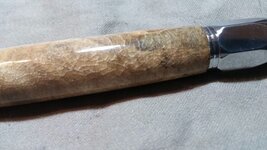I am also having problems with cracking of my finish. I am told by my suppliers that StickFast finishing system CA has a bad batch out there and this is a nationwide problem. However, they are not specifying if it is in the thin, medium, or accelerator categories or all the above. I am not sure though if I believe this as it is not happening to everyone using this system. I have also exchanged all my Stickfast Finish items with brand new lot numbered items and yesterday turned 3 pens. Still have the same issue, but only on 2 of the 3. All the same wood type and environment conditions. Shop is heated and maintains about 68 degrees. I am at a loss for the cause of this.
I have started doing a BLO/CA finish now and I have no cracking issues. That makes it seem as the accelerator is the issue as it is the component taken out. But I don't seem to get the same high quality shine.
I have done some recent research on this issue and after talking to several companies there was one common theme that really stood out.
Most often time the problem is the accelerator is to fast which results in the CA being to brittle. The makeup and age of the CA is also a key factor, some blends the older they get the more brittle they dry, added properties to the CA makes a big impact on this as well.
When working with brittle materials and you have something that flexes or shifts then you will get cracks that form like this. Shifting will happen during the cure process and if the blank changes over time.
Also I would like to point out that brand A of CA used with brand B of accelerator is not a problem at all. Mixing brands is what the manufactures does when they label accelerator anyways. One company makes the CA while another makes the accelerator.
Not all 'CA' is the same either. Additions to the mix makes a good deal of changes that should be looked at. Consider the following.
The one on the left is odorless thick, the insta-flex will never cure to be super hard as you will always be able to dent it with your fingernail, the insta-cure is standard thin CA, the end right is odorless thin CA. The insta-flex has rubber components in the mix and it does dry clear.
So in short and closing there have been a good number of reports, searchable via IAP archives, that shows stick-fast has a long and colorful history of having various problems with accelerator and CA.

